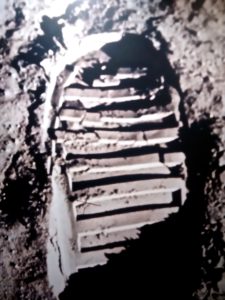 Weightless for two seconds is not a moonwalk but at the top of the Space Shot at Huntsville, Alabama’s (Rocket City) U.S. Space & Rocket Center it does give your brain a split second to wonder – am I going up or down? That question is quickly answered by a short free fall and Maddie’s (my 10-yr. old daughter) laughing scream and ear-to-ear grin. It looks like it was a successful launch. And if the Space Shot Gs aren’t enough for you, you can get a longer G-force experience in the G-Force accelerator, where you are spun around in a centrifuge like some science experiment and actually experience 3Gs of force (similar to what an astronaut experiences at left off) for about four minutes.
Weightless for two seconds is not a moonwalk but at the top of the Space Shot at Huntsville, Alabama’s (Rocket City) U.S. Space & Rocket Center it does give your brain a split second to wonder – am I going up or down? That question is quickly answered by a short free fall and Maddie’s (my 10-yr. old daughter) laughing scream and ear-to-ear grin. It looks like it was a successful launch. And if the Space Shot Gs aren’t enough for you, you can get a longer G-force experience in the G-Force accelerator, where you are spun around in a centrifuge like some science experiment and actually experience 3Gs of force (similar to what an astronaut experiences at left off) for about four minutes.
The Space Shot and the Accelerator are really popular exhibits at the Rocket Center, but they are kind of a commercial break for this truly impressive space-history museum.
More than 1,500 exhibits, from moon rocks to lunar capsules, to a full scale mock up of a Saturn V rocket and the Pathfinder Space Shuttle occupy the grounds and two buildings. And if you need more the Rocket Center also offers bus tours to the nearby Marshall Flight Center, NASA’s largest spacecraft propulsion research center.
We were there on a lark. Our oldest daughter was away on an extended vacation with a friend and we were looking for an adventure to share with Maddie. Of course, if you have kids in school in Haywood County you know that Space Camp is a big deal. So we asked Maddie if she might want to check it out and well, the rest is, as they say history.
I kind of wish I had done a little more research, but this wasn’t Space Camp this was fun camp. We got there when the center opened at 9 a.m. I mean it is July and it is Alabama, we wanted to hit the outside exhibits while the air was still cool and thin enough to breathe and spend midday in the air conditioned interior. It went mostly as planned but Maddie got such a kick out of the Space Shot and Accelerator that we had to have two manned flights.
There were lots of hand-on exhibits for Maddie to tinker with and a cool Imax movie, “A Beautiful Planet,” that showed a little about life on the space station and a lot about what our fragile planet looks like from outer space. But I wasn’t really prepared for the Saturn V Hall, with the immense rocket hanging overhead – a reminder of what a monumental undertaking the Apollo program was. There were training capsules on display showing the cramped quarters early astronauts like John Glen had to endure. And there was the actual Apollo 16 capsule and a mock up of a lunar module – Apollo 12’s quarantine facility and more.
But the thing that brought it all home to me – was that photograph of the footprint on the moon left behind by Apollo 11. I like many of my generation watched that landing on television. And when I think of that footprint in context with the Imax feature we watched – I can only hope that perhaps by going out there – we can turn around and see what we are doing down here and realize that we actually have the science and know how to protect and preserve our big blue marble and that the quest for space is not a quest for some new marble to defile and destroy but a quest to expand our knowledge and compassion and make it universal.
